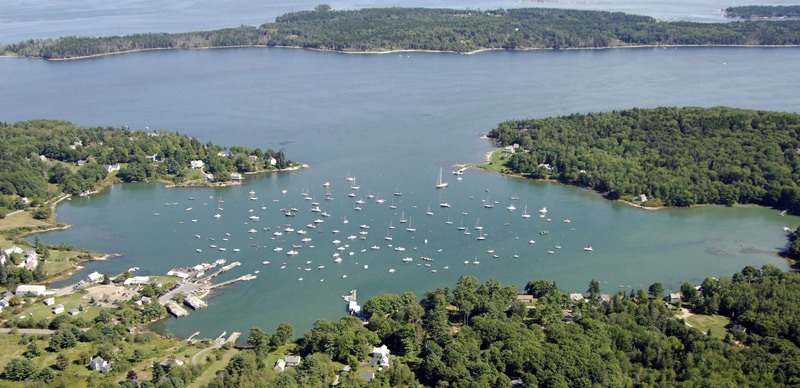
An aerial view from Round Pond to Louds Island, also known as Muscongus Island. Historical materials from the island are now searchable on the Old Bristol Historical Society’s website.
The Old Bristol Historical Society has completed the major task of scanning and cataloging 2,342 pages of archives from Louds Island, also known as Muscongus Island, so the historical materials can be searched online.
The work was done by historical society collections manager Chuck Rand.
The archives can be searched at the society’s website, oldbristolhistoricalsociety.org. The collection includes photograph albums and scrapbooks; records of the Louds Island Church Association, its ladies circle, and the Samoset Cemetery Association; genealogical information; and manuscripts.
The materials were collected by the late Lorraine Morong, who spent 55 summers there, from 1964-2019. An oral history video, in which Morong is interviewed by Rand and Old Bristol Historical Society President Bob Ives, himself a former year-round resident of the island, is available on the Old Bristol Historical Society’s YouTube channel.
Once part of Bristol, the island became an unincorporated territory overseen by the state. Nautical charts called it Muscongus Island, its Native American name, until 1962, when it was called Louds, reflecting the surname of its first English settler. Currently people of the island use both names.
It was a thriving fishing and farming community in the early 1900s, with a population of 150, two stores, and scheduled steamboat service. About a mile separates the island from the mainland near Round Pond.
The state closed its one-room school in 1962 due to low enrollment. As a result, most of the year-round residents moved off the 3-mile-long, 1-square-mile island.
One of the most recent contributions to the archive, from Stephen Mihm in 1917, is a collection of old newspaper articles from the island’s heyday, which provide a glimpse of what life was like on Muscongus at the turn of the 19th century.
An 1899 article in The Boston Globe reported “catching bait for the fishermen of Boston, Gloucester and Portland is the most profitable business, but when the bait are slack in running, they turn their attention to lobstering, mackerel fishing and catching porgies for the big oil and fertilizing factory opposite the island in Bristol.” Most families also were subsistence farmers.
The same article says that worship services were held in the upstairs hall of the only store on the island, N.O. Carter’s. That space was also used for meetings and dances.
The Portland Press Herald, in 1899, reported that there were no taxes assessed on Muscongus Island, but families were assessed tuition of $4 per student to pay for the one-room school.
By 1906, a second store had been established. The one-room schoolhouse had taken over some of the functions of the second-floor hall at Carter’s store. The school was used for church services, meetings, and dances, and also contained a lending library, according to an article in Outlook, a New York-based weekly magazine.
A 1911 article in the New York Sun said that in the absence of a minister, funeral services were conducted by the Order of Freemasons, Knights of Pythias, Odd Fellows, or Red Men, all of which were active in the small community.
In 1912 the islanders began to raise money for a church building, through fairs and similar events, but were far short of the funds needed, according to a 1914 article in the New York Tribune.
The Maine Seacoast Mission, founded in 1905 by Congregational ministers and brothers Alexander D. and Angus MacDonald to serve Maine island communities with no resident minister, helped with a solution, but it was one that linked the church and the island to a controversial episode in Maine history.
Malaga Island was one of the islands visited regularly by the mission’s ship, the Sunbeam I. It lies at the mouth of the New Meadows River in Phippsburg. Supporters of the mission in 1908 had contributed funds to build the first schoolhouse on Malaga to serve the children of biracial settlers who had occupied the island since the 1860s.
In 1912, a court determination resulted in the eviction of the Malaga settlers. The donors to the Malaga schoolhouse agreed to let the men of Muscongus Island disassemble it and use the lumber to build a church. The Sunbeam I transported the lumber to the island in 1913. The church was built that year under the supervision of master builder George Elliott, of Round Pond, and a dedication service was held in 1914.
In July 2014, a special centennial service was held in the Louds Island Brotherhood Church with more than 100 attendees.
The Louds/Muscongus materials will be stored in the archival vault under construction in the Bristol History Center in Pemaquid Falls. When the renovation of the former Poole Brothers/Hammond Lumber retail building is complete, researchers will be able to examine the original materials within the history center. Contributions for this project may be sent to OBHS, P.O. Box 87, Bristol, ME 04539 with “history center” written on the memo line of the check.



